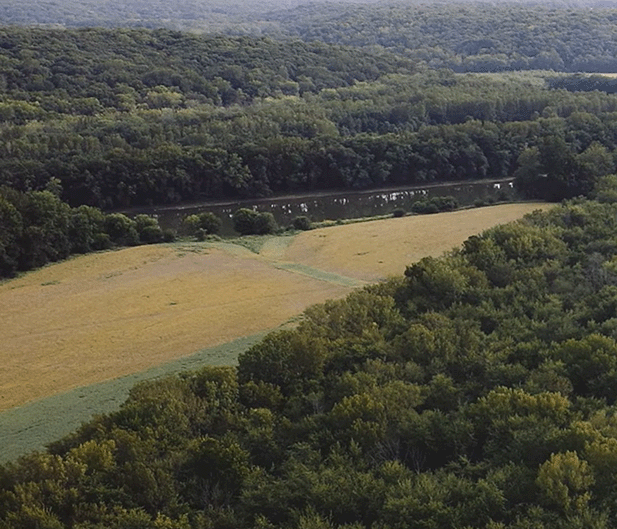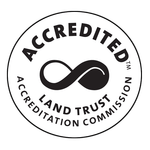News
Re-establishing Prairie in the Wea Plains
In September of 2022, NICHES added a new 200+ acre preserve in Tippecanoe County, known as the Laura Hare Bend of the Wabash East. This preserve connects NICHES Granville Sand Barrens and Roy Whistler Wildlife Area to the Wabash River on the opposite bank of the Ross Hills/Ross Reserve. NICHES worked with the previous owner to have them enroll in the USDA Wetland Reserve Easement program (WRE) to permanently retire the 140 acres of previously farmed floodplain. NICHES was then able to purchase the property with major support from Laura Hare Charitable Trust, the Roy Whistler Foundation, the McAllister Foundation, and the Community Foundation of Greater Lafayette.
This property is part of the Wea Plains where there once existed an 8,000-acre prairie. Original federal land survey records reveal that the entirety of the Laura Hare Bend of the Wabash East acres, excepting about 180 feet of riparian woodland, had been under prairie vegetation in the early 1820s. This convinced the USDA to dedicate restoration funding to establishing prairie vegetation over 140 acres. NICHES worked with USDA biologists to plan out seed mixes for roughly 32 acres of sand prairie and 108 acres of tallgrass floodplain prairie and formulate a plan to prepare the site for this restoration.
The previous owner chose not to farm the acres in 2022, leaving the fields fallow for the summer. At first this raised concerns about weed pressure and questions about how to best prepare the site for seeding. Some typical species that show up early in restoration projects were present including marestail, common ragweed, and giant ragweed. These species are considered agricultural weeds, but these are native annual species. Other species that established in the fields included non-native species like sweet Annie, reed canary grass, Japanese hops, poison-hemlock and curly dock which can all cause big problems if left unchecked. Also in the mix was an impressive array of native river scour species filling their natural niche and buzzing with wildlife, including loads of native Polygonum and Bidens species. What was happening was natural succession, and if we could keep the aggressive non-native species from becoming too abundant and promote the continued development of the naturally occurring early successional native species, we could likely set up much better nutrient conditions and development of the soil microbial communities to support the successful establishment of the prairie seed mix.
With the plan in place, work began on the ground with forestry mulching thick stands of honeysuckle in late January of 2023. NICHES staff cut by hand any stems that were too close to trees to mow and treated invasive white mulberry and Osage-orange across the property.
We returned to continue site preparation starting with Ecologic spraying reed canary grass around the restoration area the first week of May 2023. When Ecologic finished what they could within the budget for site prep spraying, I directed Stewardship Managers Justin Harmeson and Zach Neff to pick up where they left off to finish the first round of treatment across the large project area. NICHES staff kept a close eye on things and returned to follow up on all problem species as necessary. On August 1, Ecologic began mowing the 140-acre restoration area. As the contracted mowing was completed, I was on-site to monitor progress and took the opportunity to complete follow-up work on basal bark treatment of white mulberry around the restoration areas' perimeter.
Following the initial mowing, I continued to monitor the site for needed follow up work and coordinated with staff to get supplemental mowing and spraying completed. Chad Evans (WLFI meteorologist) reached out with locally sourced oak trees (white, swamp white, bur, Chinquapin, black) that he had grown from seed. Brian Beheler brought Purdue University’s tree planter and tractor over from Martell Forest to help plant the oaks on the south facing tree lines where white mulberry has been killed. This was completed as planned on October 27, 2023.
Steph Frische of Native Interest Seeds reached out about available plugs sourced from local populations. I asked that Steph set aside 2” pots of 86 wild strawberry, 24 hairy wild petunia, 214 goat’s rue, and 196 shooting star. These are all excellent species to include that are limited in commercial availability, difficult to collect/grow, and hard to establish from seed. We will plant these in the sand prairie restoration area in April or May following the dormant season drilling.
On December 6, we overseeded several species I had produced seed of at home into the restoration areas. We also had a bag of seed which Chad Evans collected from the local prairie remnants. Over the summer Justin and Zach both put effort into collecting seed in local sandy areas and overseeded several species in the best areas for their individual requirements.
On January 15, 2024, I met with Ecologic at the site to go over a few final tweaks on the project and they started drilling our seed into the frozen ground. The work continued through the week and with good drilling conditions continuing through the weekend, Ecologic’s Director of Restoration, Matt Fox, came up himself to continue working on seeding to try to get as much completed as possible before the forecasted warm up and associated rain.
We will now wait until spring to install some live plugs, provided by Steph Frische of Native Interest Seeds, to finish off the inputs to the restoration. Plugged species will include wild strawberry, hairy petunia, goat’s rue, and shooting star. Then we will continue with follow-up work on all the problem species which we have been managing at the site to ensure that they do not get any significant foothold as our prairie species begin to establish.
NICHES’ thoughtful and detailed approach to our projects keeps us learning about the best ways to go about our work and how we can improve the path to naturalization of our plantings and return more of our local landscape to natural areas with stable ecological trajectories. Our dedicated staff, combined with engaging with our partners, including government agencies, private contractors, and volunteers is the key to NICHES success in completing meaningful restoration work. Our first year at Laura Hare Bend of the Wabash East has gone just about as well as you could hope. This area has a bright future as a natural area and will likely be a local destination for passive outdoor recreation and reflection in nature for the public.
- From NICHES Stewardship Director Bob Easter's Stewardship Updates featured in the 2024 Quarter 1 Issue of The Sprout




